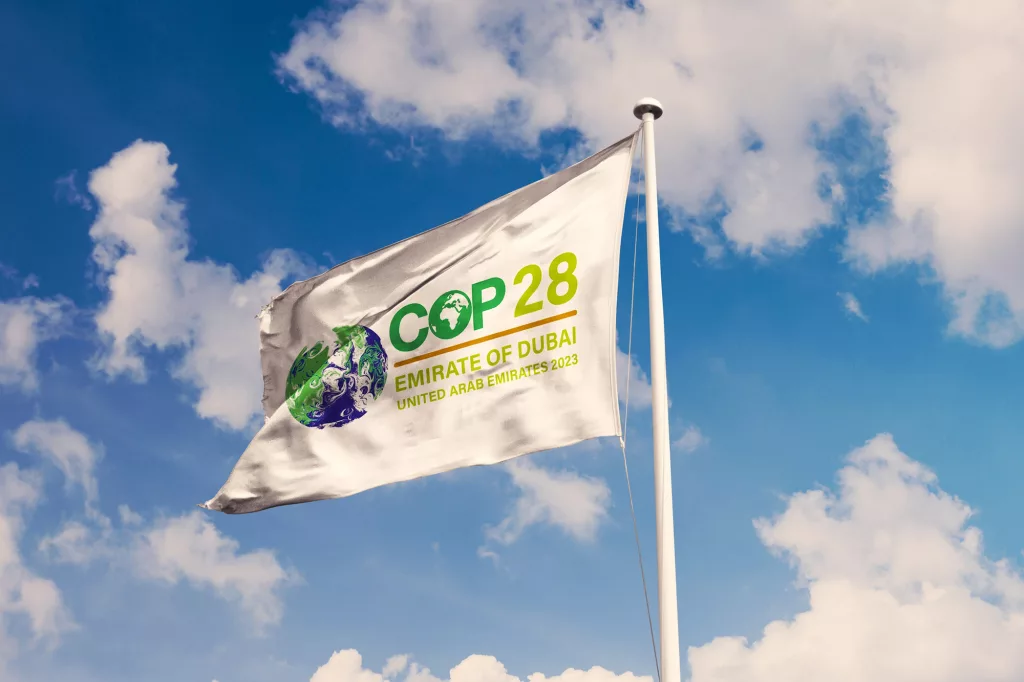UAE’s COP28 Gathering Scores Some Initial Successes
White hydrogen and AI to the rescue…? Wim Romeijn reports.
Beneath our feet, the Earth manufactures — and hides — a trove of clean energy.
In Lorraine, a former coalmining region hugging the French-German border, a reservoir containing up to 260-million metric tonnes of natural hydrogen has been discovered. That’s almost four times the annual volume of commercially produced hydrogen.

The discovery of white (natural) hydrogen in France gives a boost to small independent energy companies scouring the world for such reserves. According to Geoffrey Ellis, a geochemist at the US Geological Survey, white hydrogen may be more prevalent than previously thought. Drilling for natural gas and oil will often tap into natural hydrogen reserves — though in the past, such discoveries have been largely ignored. Earth produces around 23 million tonnes of hydrogen each year, with reserves accumulating in underground traps.
While everybody was focused on drilling for oil and gas, white hydrogen finds were routinely dismissed. That dynamic is changing, says Julian Moulin, president of Française De l’Energie, a clean-energy firm capturing methane gas from coal seams in Lorraine.
Moulin is intensifying the company’s efforts to explore and extract white hydrogen. “However,” he cautions, “it will take several years to develop the tools and technology necessary for the commercial exploitation of the hydrogen reserves.”
Grey, Green, and White
Hydrogen, a potential substitute for fossil fuels, is classified according to its provenance and manufacture. Commercial hydrogen, made by splitting water into hydrogen and oxygen, requires energy. When the process is powered by renewable energy, the resulting hydrogen is “green” but when fossil fuels are used, it is classified “grey”.
In Nature, hydrogen is continuously generated when hot water interacts with iron-rich rocks at high pressure. The US Geological Survey suspects that just a few Lorraine-sized finds could provide enough energy to power the world for centuries — even millennia.
The nascent understanding that the Earth is its own hydrogen factory has sparked a gold rush of sorts, with even Bill Gates getting in on the action. Gates provided $91m in funding from his Breakthrough Energy Ventures to Colorado start-up Koloma, which developed a process to break down iron- and magnesium-based minerals deep in the Earth’s crust to release hydrogen-rich fluids.
Scientists long believed that natural hydrogen did not accumulate in large underground reserves, but percolated through the crust in small quantities. That theory was disproved in Bourakébougou, a village some 70km north of Bamako, the capital of Mali.
Smoking Causes Harm
There, in 1987, an unproductive 108-metre-deep well caught fire after a lit cigarette was dropped into the hole. Worker Mamadou Konaré was badly burned, but survived. The fire, smokeless and blue, took weeks to snuff out. The well was capped and all but forgotten until Aliou Diallo, chair of local oil and gas company Petroma, in 2007 acquired the right to prospect the region for oil and gas.
Almost immediately, the capped well sparked the interest of Petroma.
The company brought in Canadian engineering firm Chapman Petroleum to establish what was coming out of Bourakébougou. It was 98 percent hydrogen gas. The discovery has since been hailed no less significant than the one made 164 years ago in Titusville, Pennsylvania — the world’s first commercially viable oilfield.
Today, Bourakébougou is powered almost entirely by the same hydrogen that burned the unfortunate Konaré.
Researchers at investment bank Goldman Sachs predict that the global hydrogen market will breach the $1tn barrier by 2050 as it becomes an increasingly important piece of the net-zero target.
Subsidies started pouring in, with the 2021 US Bipartisan Infrastructure Law that includes $8bn for the development of regional hubs for clean hydrogen production. The more recent Inflation Reduction Act provides a tax credit of $3 per kilo of zero-carbon fuel. But current subsidies exclude the drilling for white hydrogen.
Funding Loss and Damage
Engineers’ optimism is not shared by the 70,000 scientists, politicians, business leaders and others gathered in Dubai for the 28th Conference of Parties (COP) to the United Nations Framework Convention on Climate Change (UNFCCC). Much-maligned, and the source of much scepticism, COP28 got off to an unexpectedly rousing start. On the first day, delegates unanimously agreed to set up a loss-and-damage fund — and pledged up to $385m to help poorer nations.
The United Arab Emirates, COP28 host, agreed to provide $100m, as did the EU and Germany (a joint $245m). The US earmarked just $17.5m for the fund, while Japan committed $10m. The fund is a victory after years of wrangling over the question who should pay for the impact of climate change.
In a decision hailed as “pivotal” by the World Health Organisation (WHO), delegates from 124 countries endorsed the Declaration of Climate and Health, the first-ever political statement on the health impact of climate change. COP28 president Sultan Ahmed al-Jaber also announced an “initial tranche” of $1bn in “aggregated financing commitments”.
Former Bank of England governor — and current UN special envoy on climate action and finance — Mark Carney reminded the UAE that its ability to confront the fossil fuel industry would ultimately determine the achievements of the conference. Carney agreed that the UAE had been a leading producer of renewable energy — but noted that it sits atop some of the world’s largest oil reserves.
Sultan Al Jaber has invited criticism with unfortunate slips of the tongue which detract from his accomplishments in building consensus. Carney asked the COP28 president to openly challenge the fossil fuel industry. Sultan Al Jaber answered the call by garnering the support of 118 countries for a pledge to triple renewable energy capacity to 11,000 gigawatts by 2030.
In September, the International Energy Agency (IEA) had argued for the tripling of renewable energy to meet the goals of the 2015 Paris Agreement. Its report also stressed the need to phase-out fossil fuels not offset by carbon sequestering.
AI Debut
In Dubai, researchers and business leaders have sung the praises of AI for mapping and fighting climate change. It can analyse vast volumes of data, better than humans and computers can, leading to more accurate models and predictions. On the opening day of COP28, the UN revealed that it had struck a partnership with Microsoft for the development of an AI-powered tool to track compliance with pledges to reduce carbon emissions made by countries. Delegates from Google said that by 2030, AI may help reduce by a tenth the harmful emissions, via improved efficiencies in farming and industrial production.
Microsoft president Brad Smith admitted that the increased use of AI is causing a spike in the demand for energy, but said that his company was working on the new sources of renewable energy and improved sustainability of its data centres.
Smouldering Embers
At COP28, the call for climate action is unanimous, and loud. Promises, pledges, declarations, and commitments are made by the dozen. Creative minds are in overdrive to make a square peg fit a round hole. Political minds are also busy calculating the economic impact of promises made, and how to skirt compliance without being seen to break to agreements. Others are working out how best to monetise the sentiment.
For all its unanimity, the world remains ambiguous, if not divided, over climate change.
Since 1990, about the time when concerns about climate change started rising along with global temperatures, the world has more than doubled emissions from coal-fired power plants. The burning of coal remains the single largest source of carbon emissions: each year, 10 billion tonnes are pumped into the atmosphere via the smokestacks of some 6,500 coal-fired power plants.
Since 2014, the 38 members of the Organisation for Economic Cooperation and Development (OECD) have reduced their emissions from coal by an average of six percent annually. That reduction has been overshadowed by emissions growth in emerging economies, which account for some 80 percent of global carbon emissions.
And, for all the apparent urgency in Dubai, over 1,000 new coal-fired plants are being built. Japan, turning its back on nuclear after the Fukushima disaster, is building 22 new coal-burning plants. Once operational, they will emit almost as much CO2 as all new passenger cars sold in the US.
Politics versus Engineering
Coal is far from dead. Perhaps, then, it’s time to name and shame the “Dirty Dozen” — from Australia and India to China and South Africa, and the other coal miners and users. Otherwise, what’s the point of bringing together some 70,000 participants concerned about the climate?
Look to Lorraine for a possible solution, but don’t expect deliverance from politicians. The fault lies with the world’s diversity of interests. Human-induced climate change was caused by technology, and will be addressed by technology. Engineers and scientists hold the key.
You may have an interest in also reading…
BRIC Economies
The BRIC countries label refers to a select group of four large, developing countries (Brazil, Russia, India and China). The
Global Wage Report
Global wages remain far below pre-crisis levels, says a new United Nations report, which points to a continuing slowdown in
Ann Low, US Department of State: Good Corporate Governance is Good Business
OECD Guidelines on Corporate Governance of State-Owned Enterprises. Over the past decade, cross-border trade and investment by state-owned enterprises (SOEs)


















































































